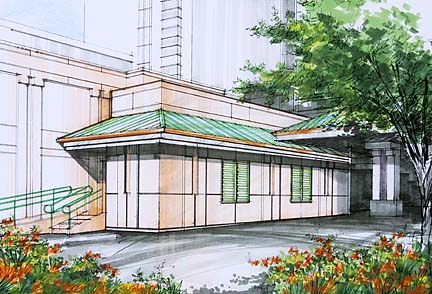

Hawaii’s bleeding Hawaii's health care facilities lost $430 million in 2000 because of uncompensated costs, reduced Medicare and Medicaid reimbursements and underpayments, according to an Ernst & Young study.
health industry
seeks federal aid
A study says isle hospitals
lost $430 million in 2000By Helen Altonn
haltonn@starbulletin.comThe struggling facilities have managed to continue operating by laying off staff, closing clinics and reducing services, said Richard E. Meiers, president and chief executive officer of the Healthcare Association of Hawaii.
The period after the Sept. 11 terrorist attacks has been slow for hospitals, he said.
The association is appealing to the Legislature, Congress and the Bush administration to increase Medicare and Medicaid reimbursements at least to cover actual costs of health care services. At a minimum, they hope to prevent further funding losses.

|
The association retained Ernst & Young three years ago to examine financial problems of hospitals and nursing facilities as their losses began to mount.It represents 43 acute-care hospitals, long-term care and other health facilities. Some face severe financial hardship and ruin if nothing is done to change the trend of the past few years, health care officials said.
"What is extremely frightening is, we expect deep cuts in federal reimbursements this year," Meiers said.
Representatives of all 50 state associations agreed last week at an American Hospital Association meeting in Washington to discuss with President Bush and his administration "the fact that we cannot afford any more of these cuts," Meiers said.
He said more cuts are expected on top of those imposed by the Balanced Budget Act of 1997, which still has two years to go and "is what hurt us so bad."
Ernst & Young's findings for Hawaii hospitals in 2000 document these losses: $95 million from charity care and bad debt -- climbing from $52 million in 1998; $20 million in costs for community programs; $19 million for medical education; $30 million in deficit Medicare payments; $32 million in funding deleted by the Balanced Budget Act; and $232 million in Medicare underpayments.
Medicare payments are 37 percent higher for mainland hospitals than those in Hawaii, although costs of providing care are significantly higher here, officials point out.
If the picture does not change, Ernst & Young estimates a $2.04 billion loss for hospitals from 1998 to 2002. The financial impact in 2001 will be examined this year.
"We don't know what will happen in the next study, including the 9/11 period," Meiers said.
He said the associations are trying to convince Congress and the White House that emergency rooms are as vital as police and fire departments, particularly when they are expected to be ready to respond to terrorist events.
Yet the hospital association leader reported that "for the first time the health care wall across the nation is crumbling," Meiers said. "We've seen the degradation of our own health care system the last 10 years."
The AHA's Partnership for Community Safety, formed in December by national firefighter, public health and health care associations, sent Bush a letter last week stressing the importance of funding for public health and medical response planning.
A lot of money is going into the Queen's Medical Center's decontamination unit and other efforts to prepare for terrorism in Hawaii, without any federal funding, Meiers said.
Among other repercussions of the Sept. 11 events, he said, hospital beds have opened up across the country with people choosing not to have elective procedures after the stock market plunged.
Numbers of the medically uninsured also ballooned, with an additional 900,000 nationally and an estimated 30,000 in Hawaii, he said.
The Healthcare Association again this year is asking the Legislature to set Medicaid payments at a level to cover costs of health care, Meiers said, as well as continuation of programs to help insure those who lost jobs after Sept. 11.
Joan P. White, association vice president, said at least 80 percent of people in long-term care facilities are covered by below-cost Medicaid payments that are falling further behind.
The state Department of Human Services also plans to reduce Medicaid payments in 2002-2003, ruling out matching federal money, she said. The total loss is estimated at $3 million.
On the federal level, Balanced Budget improvement and relief acts that restored some previously cut Medicare funds will end Sept. 30, she said. "So reimbursements will drop like rock."
Delays in Medicaid payments have forced some facilities to go on a line of credit to meet their payroll, she said.
Rose Ann Poyzer, vice president of the association's Home Care and Hospice Division, said facilities have not received Medicaid payments for up to eight months.
"My providers can't continue to provide service if they're not reimbursed for it -- at least the cost," she said. "You can't go into a restaurant and get a bill for $20 and only pay $15."